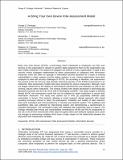A Bring Your Own Device Risk Assessment Model

View/
Publication Date
2021Author
M. Cyprian Oonge S. Omboga, Muhambe, T. Mukisa , Ratemo
Metadata
Show full item recordAbstract/
Bring Your Own Device (BYOD), a technology where individuals or employees use their own
devices on the organization’s network to perform tasks assigned to them by the organization has
been widely embraced. The reasons for adoption are diverse in every organization. In spite of the
security control strategies implemented by these organizations to safeguard their information
resources, there has been an upsurge in information security breaches as a result of existing
vulnerabilities in these systems and the legacy systems in use. Various approaches have been
employed to deal with security challenges in BYOD, but according to literature, risk assessment
has proved to be the first key step towards improving security of the BYOD environment in an
enterprise. Risk assessment models have been proposed by various researchers, although, most
are largely influenced by the degree of technological advancement and utilization as well as the
working cultures within institutions. The existing models were largely developed in technologically
advanced countries and thus do not fit well in developing countries. This study sought to develop
flexible BYOD risk assessment model that can be adopted by varied institutions to secure their
information resources. The study was carried out in Five (5) purposively selected state
universities in Kenya. The research adopted a mixed research design approach with mixed
sampling technique utilized to select the participants. Reliability and validity of data collection
tools were evaluated and recommended by IT security and network experts. The qualitative and
quantitative data was collected by interviewing experts and administering a questionnaire to
sampled participants. The developed model was validated both statistically and by experts. The
findings revealed that threats and vulnerabilities contributed to 39.9% and 69.2% respectively to
the risk of the BYOD environment while Data Encryption (DE) and Software Updates (SU) came
out strongly as intervening variables which have a major impact on the relationship between the
dependent and independent variables.
